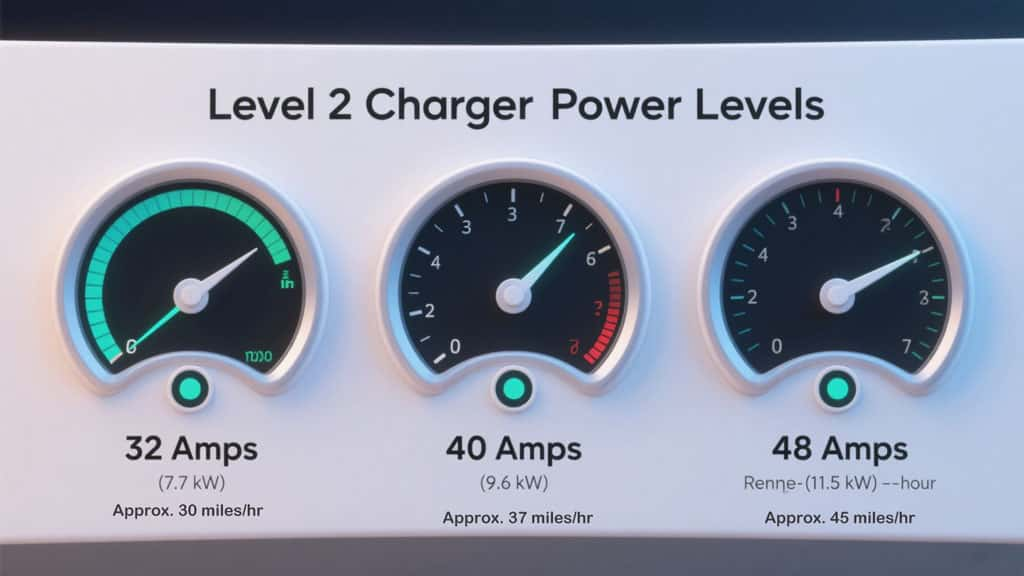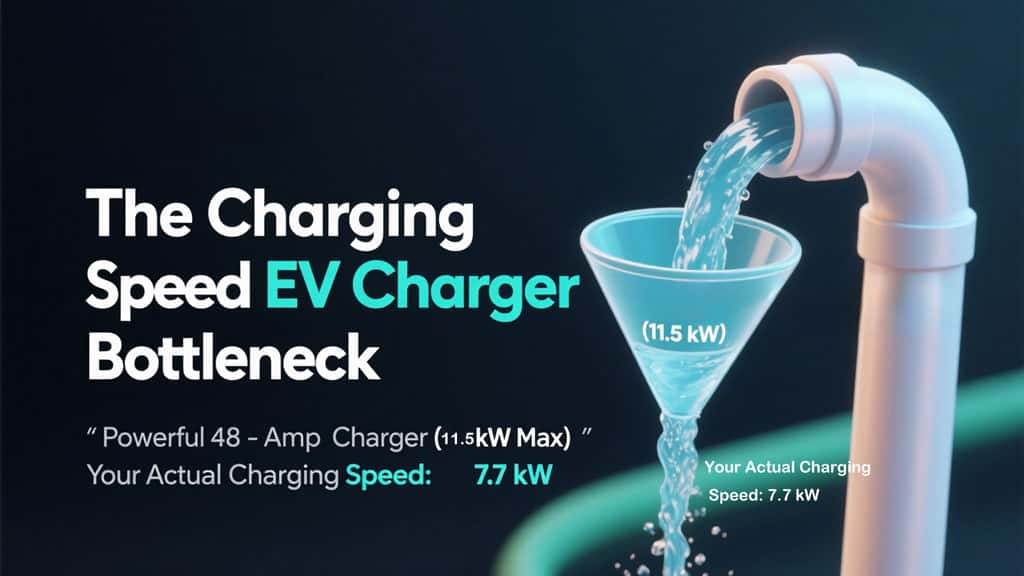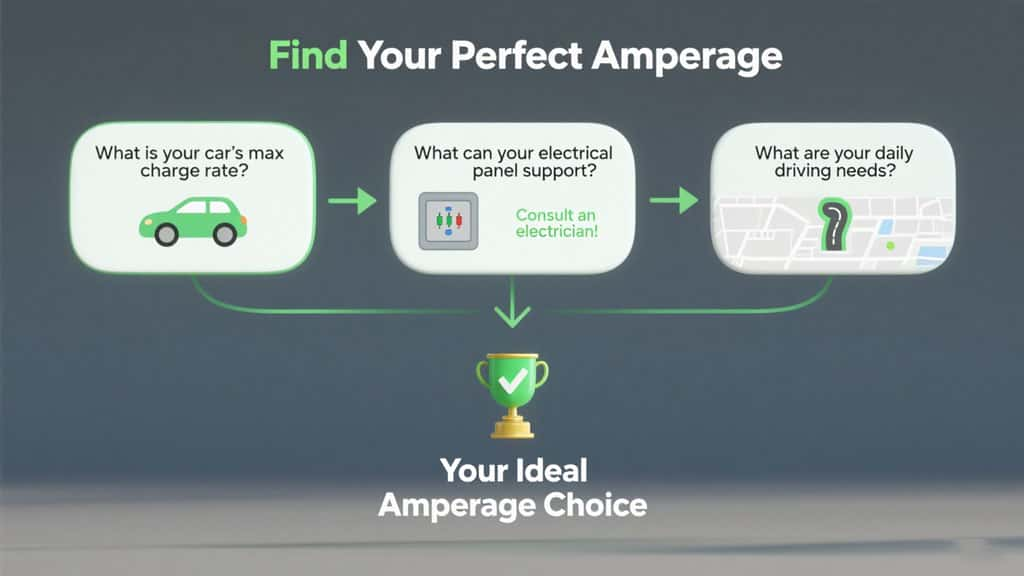Level 2 EV chargers typically offer a range of power options, most commonly from 16 amps up to 48 amps. For most home and light commercial installations in 2025, the most popular and practical choices are 32 amps, 40 amps, and 48 amps. Choosing between them is one of the most important decisions you will make for your EV charging setup.
There isn't one single "best" amperage for everyone. The right choice depends on your specific vehicle, your property's electrical capacity, and your daily driving needs. This guide will provide a clear, step-by-step framework to help you select the perfect amperage, ensuring you get the performance you need without overspending. For those new to the topic, our guide on What is a Level 2 Charger? provides excellent background information.
Common Level 2 Charger Amps and Power Output (kW)
First, let's look at the options. A Level 2 charger's power, measured in kilowatts (kW), is determined by its amperage and the 240-volt circuit it runs on. It's also important to remember the National Electrical Code (NEC) "80% Rule," which means a charger's continuous draw should be no more than 80% of its circuit breaker's rating.
Here’s what that looks like in practice:
| Charger Amperage | Required Circuit Breaker | Power Output (@240V) | Approx. Range Added Per Hour |
| 16 Amps | 20 Amps | 3.8 kW | 12-15 miles (20-24 km) |
| 24 Amps | 30 Amps | 5.8 kW | 18-22 miles (29-35 km) |
| 32 Amps | 40 Amps | 7.7 kW | 25-30 miles (40-48 km) |
| 40 Amps | 50 Amps | 9.6 kW | 30-37 miles (48-60 km) |
| 48 Amps | 60 Amps | 11.5 kW | 37-45 miles (60-72 km) |

Why Your Car's On-Board Charger Dictates Charging Speed
This is the most important secret in EV charging. You can buy the most powerful 48-amp charger available, but it will not charge your car any faster than your car's On-Board Charger (OBC) can accept.
The charging speed is always limited by the "weakest link" in the chain. If your car's OBC has a maximum acceptance rate of 7.7 kW, it doesn't matter if the charger can offer 11.5 kW—your car will simply never ask for more than 7.7 kW.
Check your car's specifications before you buy a charger. Here are some popular examples:
| Vehicle Model | Max AC Charging Power | Equivalent Max Amps |
| Chevrolet Bolt EV (2022+) | 11.5 kW | 48 Amps |
| Ford Mustang Mach-E | 11.5 kW | 48 Amps |
| Tesla Model 3 (Standard Range) | 7.7 kW | 32 Amps |
| Nissan LEAF (Plus) | 6.6 kW | ~28 Amps |
Buying a 48-amp charger for a Tesla Model 3 Standard Range is a waste of money. The car will never charge faster than its 32-amp limit.

A 3-Step Guide to Choosing Your Perfect Level 2 Charger Amps
Follow these simple steps to make the right choice.
Step 1: Check Your Vehicle's Max Charging Rate
This is your "speed limit." Look in your vehicle's owner's manual or search online for its on-board charger specs. There is no reason to buy a charger with more amps than your car can handle.
Step 2: Assess Your Property's Electrical Panel
A Level 2 charger adds a major electrical load to your home or business. You must consult a licensed electrician to perform a "load calculation."
This assessment will determine if your current panel has enough spare capacity to safely add a new 40-amp, 50-amp, or 60-amp circuit. This step is also where you'll decide on the physical connection, often a NEMA 14-50 outlet, which is very common for 40-amp chargers.
Step 3: Consider Your Daily Driving Habits
Be honest about how much you drive.
•If you drive 30-40 miles a day: A 32-amp charger can fully replenish that range in less than two hours overnight. It is more than sufficient for most people.
•If you have two EVs, a long commute, or want faster turnarounds: A 40-amp or 48-amp charger may be a better fit, but only if your car and electrical panel can support it.

How Your Amperage Choice Affects Installation Costs
Choosing a higher amperage charger directly impacts your budget. The Home EV Charger Installation Cost is not just about the charger itself.
A 48-amp charger requires a 60-amp circuit. Compared to a 40-amp circuit for a 32-amp charger, this means:
•Thicker, more expensive copper wiring.
•A more expensive 60-amp circuit breaker.
•A higher likelihood of needing a costly main panel upgrade if your capacity is limited.
Always get a detailed quote from your electrician that covers these elements.
The Business Perspective: Amps for Commercial & Fleet Use
For commercial properties, the decision is even more strategic. While faster charging seems better, installing many high-amperage chargers can require massive, expensive electrical service upgrades.
A smarter strategy often involves using more chargers at a lower amperage, like 32A. When combined with smart load management software, a property can serve many more employees, tenants, or customers simultaneously without overloading its electrical system. This is a key difference when considering Single Phase vs Three Phase EV Chargers, as three-phase power, common in commercial sites, provides more flexibility for these installations.
Does Faster Charging Mean More Maintenance?
Not necessarily, but durability is key. A high-quality charger, regardless of its amperage, will be reliable. Choosing a well-built unit from a reputable manufacturer is crucial for minimizing long-term EV Charging Station Maintenance Costs and ensuring your investment lasts.
Can I Install Even Faster Chargers at Home?
You might wonder about even faster options. While it is technically possible to get a DC Fast Charger at Home, it is extremely rare and incredibly expensive. It requires a commercial-grade three-phase electrical service and can cost tens of thousands of dollars, making Level 2 the universal standard for home charging.
Safety First: Why Professional Installation is Non-Negotiable
After you have chosen your charger, you might be tempted to install it yourself to save money. This is not a DIY project. A Level 2 charger installation involves working with high-voltage electricity and requires a deep understanding of electrical codes.
For safety, compliance, and to protect your warranty, you must hire a licensed and insured electrician. A professional ensures the job is done right, giving you peace of mind.
Here’s why hiring a professional is essential:
•Personal Safety: A 240-volt circuit is powerful and dangerous. Improper wiring can lead to a risk of electrical shock or, even worse, a fire. An electrician has the training and tools to perform the installation safely.
•Code Compliance: The installation must meet the standards of the National Electrical Code (NEC), specifically Article 625. A licensed electrician understands these requirements and ensures your setup will pass any required inspections.
•Permits and Inspections: Most local authorities require an electrical permit for this type of work. In most cases, only a licensed contractor can pull these permits, which trigger a final inspection to verify the work is safe and up to code.
•Protecting Your Warranties: A DIY installation will almost certainly void the manufacturer's warranty on your new EV charger. Furthermore, in the event of an electrical issue, it could even jeopardize your homeowner's insurance policy.
•Guaranteed Performance: An expert will not only install your charger safely but will also ensure it is configured correctly to deliver the optimal charging speed for your vehicle and home.
Match the Amps to Your Needs, Not the Hype
So, how many amps is a level 2 charger? It comes in a range of sizes designed for different needs. The most powerful option is not always the best one.
The smartest choice is always a charger that perfectly balances three things:
1.Your vehicle’s maximum charging speed.
2.Your property’s available electrical capacity.
3.Your personal driving habits and budget.
By following this guide, you can confidently choose the right amperage, ensuring you get a fast, safe, and cost-effective charging solution that will serve you well for years.
FAQ
1.What happens if I buy a 48-amp charger for a car that only takes 32 amps?
Nothing bad will happen, but it is a waste of money. The car will simply communicate with the charger and tell it to only send 32 amps. You will not get a faster charge.
2.Is a 32-amp Level 2 charger enough for most new EVs?
For daily charging at home, yes. A 32-amp charger provides about 25-30 miles of range per hour, which is more than enough to fully charge almost any EV overnight from typical daily usage.
3.Will I definitely need a new electrical panel for a 48-amp charger?
Not definitely, but it is more likely. Many older homes have 100-amp service panels, which can be tight for a new 60-amp circuit. A load calculation by a certified electrician is the only way to know for sure.
4.Does charging at a higher amperage damage my car's battery?No. AC charging, regardless of the Level 2 amperage, is gentle on your car's battery. The car's on-board charger is designed to manage the power safely. This is different from repeated, high-heat DC fast charging, which can affect long-term battery health.
5.How can I find out my home's current electrical panel capacity?
Your main electrical panel has a large main breaker at the top, which will be labeled with its capacity (e.g., 100A, 150A, 200A). However, you should always have a licensed electrician verify this and determine the actual available load.
Authoritative Sources
1.U.S. Department of Energy (DOE) - Alternative Fuels Data Center: This is the DOE's official resource page providing foundational information for consumers about charging electric vehicles at home, including Level 1 and Level 2 charging.
2.Qmerit - EV Charger Installation Services: As one of the largest networks of certified EV charger installers in North America, Qmerit provides extensive resources and services related to residential and commercial installations, reflecting industry best practices.
Post time: Jul-07-2025


